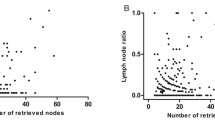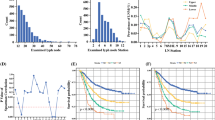Abstract
Objective
The current American Joint Committee on Cancer staging system for esophageal cancer is based on lymph node location, irrespective of the number of involved and examined lymph nodes.
Methods
We enrolled 488 patients receiving primary curative resection without neoadjuvant therapy for esophageal cancer between 1995 and 2006. The importance of total resected lymph node number (TLN) and metastatic lymph node number (MLN) and ratio (MLR) on patient survival was investigated.
Results
The overall 3-year survival rate was 35.4%. The 3-year survival rate was equivalent among patients in N1 (23.3%), M1a (22.0%), and nonregional lymph node metastasis-related M1b (18.5%, p = 0.321). No survival difference was noted between patients with TLN < 15 or ≥15 (p = 0.249). Both MLN and MLR significantly predicted patient survival. The 3-year survival rate was 52.3%, 29.2%, and 8.0% for patients with MLN = 0, 1–3, and ≥4, respectively (p < 0.001). For patients with MLR = 0–0.2 or >0.2, the 3-year survival rate was 28.7% and 9.8%, respectively (p < 0.001). However, survival rate differences were more evident when TLN was more than 15.
Conclusions
We recommend designating both regional and nonregional lymph nodes as N nodes. MLN and MLR, but not TLN, are prognostic factors in esophageal cancer.




Similar content being viewed by others
References
American Joint Committee on Cancer (AJCC). Cancer staging manual. 6th ed. New York, NY: Springer, 2002.
Bogoevski D, Onken F, Koenig A, Kaifi JT, Schurr P, Sauter G, Izbicki JR, Yekebas EF. Is it time for a new TNM classification in esophageal carcinoma? Ann Surg 2008;247:633–641.
Rizk N, Venkatraman E, Park B, Flores R, Bains MS, Rusch V. The prognostic importance of the number of involved lymph nodes in esophageal cancer: implications for revisions of the American Joint Committee on Cancer staging system. J Thorac Cardiovasc Surg 2006;132:1374–1381.
Rice TW, Blacestone EH, Rybicki LA, Adelstein DJ, Murthy SC, DeCamp MM, Goldblum JR. Refining esophageal cancer staging. J Thorac Cardiovasc Surg 2003;125:1103–1113.
Korst RJ, Rusch VW, Venkatraman E, Bains MS, Burt ME, Downey RJ, Ginsberg RJ. Proposed revision of the staging classification for esophageal cancer. J Thorac Cardiovasc Surg 1998;115:660–670.
Hofstetter W, Correa AM, Bekele N, Ajani JA, Phan A, Komaki RR, Liao Z, Maru D, Wu TT, Mehran RJ, Rice DC, Roth JA, Vaporciyan AA, Walsh GL, Francis A, Blackmon S, Swisher SG. Proposed modification of nodal status in AJCC esophageal cancer staging system. Ann Thorac Surg 2007;84:365–375.
Dhar DK, Hattori S, Tonomoto Y, Shimoda T, Kato H, Tachibana M, Matsuura K, Mitsumoto Y, Little AG, Nagasue N. Appraisal of a revised lymph node classification system for esophageal squamous cell cancer. Ann Thorac Surg 2007;83:1265–1272.
Mariette C, Piessen G, Briez N, Triboulet JP. The number of metastatic lymph nodes and the ratio between metastatic and examined lymph nodes are independent prognositc factors in esophageal cancer regardless of neoadjuvant chemoradiation or lymphadenectomy extent. Ann Surg 2008;247:365–371.
Altorki N, Zhou XK, Stiles B, Port JL, Paul S, Lee PC, Mazumdar M. Total number of resected lymph nodes predicts survival in esophageal cancer. Ann Surg 2008;248:221–226.
Roder JD, Busch R, Stein HJ, Fink U, Siewert JR. Ratio of invaded to removed lymph nodes as a prognostic of survival in squamous cell carcinoma of the esophagus. Br J Surg 1994;81:410–413.
Eloubeidi M, Desmond R, Arduedas MR, Reed CE, Wilcox CM. Prognostic factors for the survival of patients with esophageal carcinoma in the U.S. Cancer 2002;95:1434–1443.
Peyre CG, Hagen JA, DeMeester SR, Altorki NK, Ancona E, Griffin SM, Holscher A, Lerut T, Law S, Rice TW, Ruol A, Van Lanschot JJB, Wong J, DeMeester TR. The number of lymph nodes removed predicts survival in esophageal cancer: An international study on the impact of extent of surgical resection. Ann Surg 2008;248:549–556.
Greenstein AJ, Little VR, Swanson SJ, Divino CM, Packer S, Wisnivesky JP. Effect of the number of lymph nodes sampled on postoperative survival node-negative esophageal cancer. Cancer 2008;112:1239–1246.
Greenstein AJ, Little VR, Swanson SJ, Divino CM, Packer S, Wisnivesky JP. Prognostic significance of the number of lymph node metastases in esophageal cancer. J Am Coll Surg 2008;206:239–246.
National Comprehensive Cancer Network. Esophgeal Cancer Clinical Practice Guidelines in Oncology (V.1.2008). Available at: www.nccn.org.
Akiyama H, Tsurumaru M, Udagawa H, Kajiyama Y. Radical lymph node dissection for cancer of the thoracic esophagus. Ann Surg 1994;220:364–373.
Hagen JA, DeMeester SR, Peters JH, Chandrasoma P, Demeester TR. Curative resection for esophageal adenocarcinoma. Analysis of 100 en bloc esophagectomies. Ann Surg 2001;234:520–531.
Christie NA, Rice TW, DeCamp MM, Goldblum JR, Adelstein DJ, Zuccaro G, Rybicki LA, Blackstone EH. M1A/M1B esophageal carcinoma: clinical revelance. J Thorac Cardiovasc Surg 1999;118:900–907.
Tachibana M, Dhar DK, Kinugasa S, Kotoh T, Shibakita M, Ohno S, Masunaga R, Kubota H, Nagasue N. Esophageal cancer with distant lymph node metastasis: prognostic significance of metastatic lymph node ratio. J Clin Gastroenterol 2000 Dec;31:318–322.
Veeramachaneni NK, Zoole JB, Decker PA, Putnam JB, Meyers BF. Lymph node analysis in esophageal resection: American college of surgeons oncology group Z0060 trial. Ann Thorac Surg 2008;86:418–421.
Altman DG, Simon R. Statistical aspects of prognostic factor studies in oncology. Br J Cancer 1994;69:979–985.
Author information
Authors and Affiliations
Corresponding author
Rights and permissions
About this article
Cite this article
Hsu, WH., Hsu, PK., Hsieh, CC. et al. The Metastatic Lymph Node Number and Ratio Are Independent Prognostic Factors in Esophageal Cancer. J Gastrointest Surg 13, 1913–1920 (2009). https://doi.org/10.1007/s11605-009-0982-8
Received:
Accepted:
Published:
Issue Date:
DOI: https://doi.org/10.1007/s11605-009-0982-8




